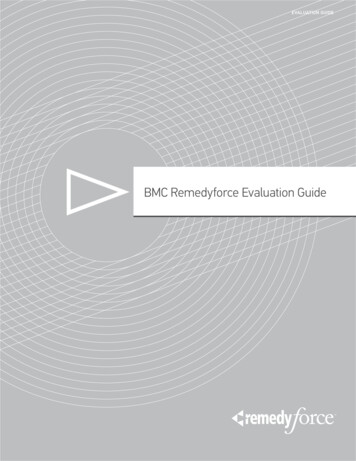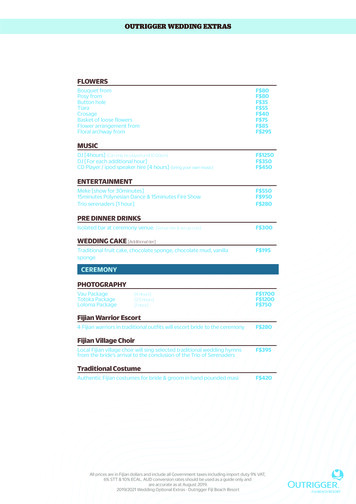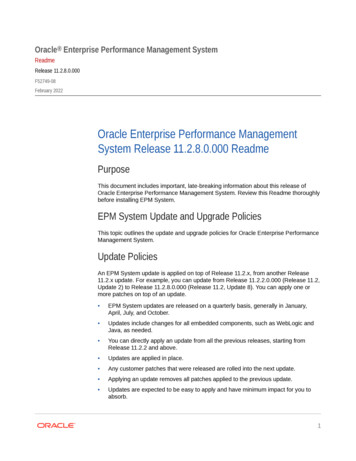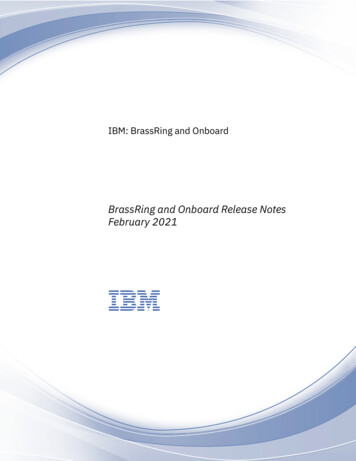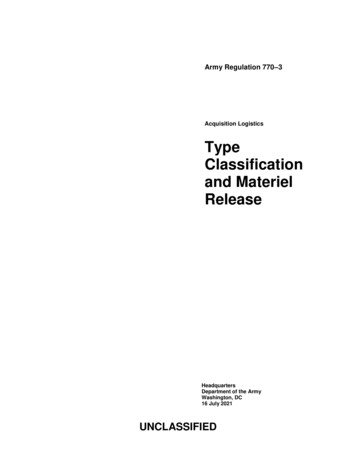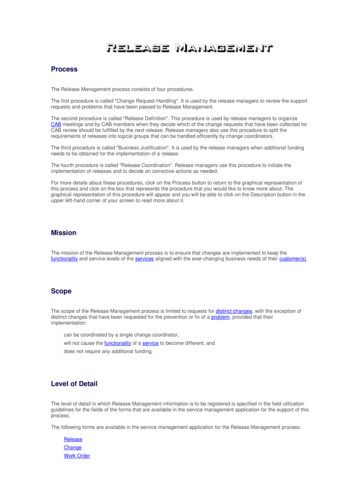
Transcription
ProcessThe Release Management process consists of four procedures.The first procedure is called "Change Request Handling". It is used by the release managers to review the supportrequests and problems that have been passed to Release Management.The second procedure is called "Release Definition". This procedure is used by release managers to organizeCAB meetings and by CAB members when they decide which of the change requests that have been collected forCAB review should be fulfilled by the next release. Release managers also use this procedure to split therequirements of releases into logical groups that can be handled efficiently by change coordinators.The third procedure is called "Business Justification". It is used by the release managers when additional fundingneeds to be obtained for the implementation of a release.The fourth procedure is called "Release Coordination". Release managers use this procedure to initiate theimplementation of releases and to decide on corrective actions as needed.For more details about these procedures, click on the Process button to return to the graphical representation ofthis process and click on the box that represents the procedure that you would like to know more about. Thegraphical representation of this procedure will appear and you will be able to click on the Description button in theupper left-hand corner of your screen to read more about it.MissionThe mission of the Release Management process is to ensure that changes are implemented to keep thefunctionality and service levels of the services aligned with the ever-changing business needs of their customer(s).ScopeThe scope of the Release Management process is limited to requests for distinct changes, with the exception ofdistinct changes that have been requested for the prevention or fix of a problem, provided that theirimplementation:can be coordinated by a single change coordinator,will not cause the functionality of a service to become different, anddoes not require any additional funding.Level of DetailThe level of detail in which Release Management information is to be registered is specified in the field utilizationguidelines for the fields of the forms that are available in the service management application for the support of thisprocess.The following forms are available in the service management application for the Release Management process:ReleaseChangeWork Order
Click on a form to obtain the field utilization guidelines for each of its fields.Roles & ResponsibilitiesThe table below lists the different roles that are involved in the Release Managementprocess, along with their respective responsibilities. Click on a role to review its profile.RoleResponsibilityCAB memberDecides which of the change requests that have been collected forCAB review should be rejected, which should be fulfilled by the nextrelease, and which should be reviewed again during the next CABmeeting.Release managerReviews the change requests for the service(s) for which he/she actsas the release manager after they have been passed on from ChangeManagement.Organizes and facilitates the CAB meetings for the service(s) forwhich he/she acts as the release manager.Splits the requirements of releases into logical groups that can behandled efficiently by change coordinators.Prepares a business case for a new release when additional fundingis needed for its implementation.Initiates the implementation of releases and decides on correctiveactions as needed.Organizes and conducts post-implementation meetings to collectimprovement suggestions for future releases.Key Performance IndicatorsThe table below presents the key performance indicator (KPIs) that has been selected fortracking the success of the Release Management process.KPIDefinitionSuccessful releasesThe number of completed releases with theCompletion code field set to "Implemented", dividedby the total number of completed releases.FrequencyUnitMonthly%BeneficiariesThe roles that rely on the Release Management process are listed in the table below,along with their respective requirements for the Release Management process.
BeneficiaryRequirementCAB membersInformation regarding support requests that have been passed toRelease Management, but which have not yet been rejected or linkedto a release.Change coordinatorsDetailed descriptions of those requirements of a release that theyhave been asked to take responsibility for.Problem managersInformation regarding the progress of releases which implementationwill prevent or fix one or more problems.Information added to problems following their rejection during a CABmeeting or the completion of the release to which they are linked.Service desk agentsInformation regarding the progress of releases so that the customersof the support requests that have been linked to releases can be keptup-to-date.Information added to support requests following their rejection duringa CAB meeting or the completion of the release to which they arelinked.OwnerThe owner of the Release Management process is the Service Management CAB.This CAB is responsible for reviewing, and subsequently approving or rejecting, requests for improvement of theRelease Management process and its supporting functionality in the service management application.Process
Procedure 1, Change Request HandlingAfter a change coordinator of a service has passed a change request to the release manager of the service, therelease manager reviews the request to gain an understanding of its requirements. The release manager passesthe change request back to the change coordinator if it does not require the involvement of Release Management.Only change requests that ask for the implementation of a distinct change must be handled by ReleaseManagement, with the exception of change requests that have been submitted for the prevention or fix of aproblem, provided that their implementation:can be coordinated by a single change coordinator,will not cause the functionality of a service to become different, anddoes not require any additional funding.If the request does require the involvement of Release Management, the release manager checks to see if itrequires CAB approval. The CAB does not need to review the change request if it asks for the implementation of achange to prevent or fix of a problem and if this change will not cause the functionality of a service to becomedifferent. If CAB approval is required, however, the release manager adds the change request to the list ofrequests that are waiting to be reviewed during the next meeting of the service's CAB.Procedure 1, Change Request Handling
Work InstructionsProcedure StepWork Instructions for Release Managers1.1.1Examine the information in the support request orproblem to gain an understanding of the changerequest's requirements.Work InstructionsProcedure StepWork Instructions for Release Managers1.2.1If the change request does not require theinvolvement of Release Management, continue with1.3.1. Otherwise go to 1.4.1.Note: Change requests that ask for the implementation ofa distinct change must be handled by ReleaseManagement, with the exception of change requeststhat have been submitted for the prevention or fix ofa problem, provided that their implementation:can be coordinated by a single change coordinator,will not cause the functionality of a service to become different,anddoes not require any additional funding.
Work InstructionsProcedure StepWork Instructions for Release Managers1.3.1Ensure that the change request is returned to theChange Management process.1.3.2 If the change request was received from IncidentManagement in the form of a support request, dothis by specifying in its Information update fieldthat the change can be implemented without theinvolvement of the Release Management process.Select the change coordinator who assigned thechange request to you in the Member field of thesupport request. Leave the Status field of thesupport request set to "Assigned".Note: Do not set the Status field of the support request to"Rejected", as that will cause the servicemanagement application to automatically assign itto the service desk.1.3.3 Similarly, if the change request was received fromProblem Management in the form of a problem, dothis by specifying in its Information update fieldthat the change can be implemented without theinvolvement of the Release Management process.Select the change coordinator who assigned thechange request to you in the Member field of theproblem. Leave the Status field of the problem setto "Change Requested".Note: Do not set the Status field of the problem to"Rejected", as that will cause the servicemanagement application to automatically assign theproblem to its problem manager.Work InstructionsProcedure StepWork Instructions for Release Managers1.4.1Go to 2.9.1 if the request asks for theimplementation of a change to prevent or fix of aproblem and if this change will not cause thefunctionality of a service to become different.Otherwise continue with 1.5.1.
Work InstructionsProcedure StepWork Instructions for Release Managers1.5.1Estimate the effort of internal employees and longterm contractors that will be required to get therequested change implemented.1.5.2 Also estimate the cost of CIs, services and supportthat will need to be acquired from suppliers in orderto get the requested change implemented.Note: Consult with change coordinators and specialists asneeded to come up with realistic estimates.1.5.3 If the change request was received from IncidentManagement in the form of a support request, enterboth estimates and the assumptions on which theyare based in the Information update field of thesupport request.1.5.4 Similarly, if the change request was received fromProblem Management in the form of a problem,enter both estimates and the assumptions on whichthey are based in the Information update field of theproblem.Work InstructionsProcedure StepWork Instructions for Release Managers1.6.11.6.2If the change request was received from IncidentManagement in the form of a support request, clickon its Relations tab and link it to the change thatacts as a placeholder for requests that are waiting tobe reviewed during the next meeting of the service'sCAB. Indicate in the Information update field of thesupport request that the "Responsibility forcoordination has been accepted by ReleaseManagement". Set the Status field of the supportrequest to "Change Pending".Similarly, if the change request was received fromProblem Management in the form of a problem,click on its Relations tab and link it to the changethat acts as a placeholder for requests that arewaiting to be reviewed during the next meeting of
the service's CAB. Indicate in the Informationupdate field of the problem that the "Responsibilityfor coordination has been accepted by ReleaseManagement". Set the Status field of the problem to"Change Pending".Procedure 2, Release DefinitionWhen the next CAB meeting for a service is due, the release manager of the service sends out the invitations tothe service's CAB members. In the invitation, the release manager specifies the deadline until which changerequests can be submitted for review during the next CAB meeting. After the change request submission deadlinehas passed, the release manager finalizes the list of change requests that will be reviewed during the next CABmeeting and sends it to the CAB members so that they can discuss the change requests internally before themeeting.The finalized list of change requests is reviewed during the meeting. After all change requests have beenreviewed, each CAB member lets the release manager know which change requests he/she would like to seerejected and which change request(s) he/she would like to see included in the next release. A change request isrejected when at least two-thirds of the CAB members agree that it should be rejected. Similarly, a change requestis included in the next release when two-thirds or more of the CAB members have asked for it to be included.Change requests that are neither rejected or included in the next release will be reviewed again during the nextCAB meeting. Before closing the CAB meeting, the CAB members agree on the date, time and location of the nextCAB meeting.After the CAB meeting, the release manager ensures that the requesters of the rejected change requests areinformed by completing these change requests. Having done this, the release manager publishes the minutes ofthe CAB meeting and registers the new release. To this release he/she links a change for the coordination of therelease and links the change request(s) that are to be included in the release to this change.The release manager then reviews these change requests with the change coordinators of the service for whichthe release is to be implemented and the change coordinators of the supporting services that will also need to bechanged. Together they divide the requirements of the different change requests amongst them and they draft ahigh-level implementation plan that indicates the duration of each change, as well as the dependencies betweenthese changes.Procedure 2, Release Definition
Work InstructionsProcedure StepWork Instructions for Release Managers2.1.1Work InstructionsE-mail the invitations for the upcoming meeting ofthe service's CAB to all its members. Be sure tospecify the deadline until which change requestscan be submitted for review during this CABmeeting.
Procedure StepWork Instructions for Release Managers2.2.1After the change request submission deadline forthe next CAB meeting has passed, prepare a list thatsummarizes the details of each change request thatis to be reviewed by the CAB. These requests arelinked to the change that acts as the placeholder forthe service's change requests that are awaiting CABreview.Note: This list of change requests should provide thefollowing columns of information:Support request or problem number,Name and organization of the requester,Description of the change request,Estimated implementation effort, and2.2.2Estimated implementation cost.E-mail the finalized list of change requests that willbe reviewed during the upcoming CAB meeting toall members of the CAB. This allows them todiscuss the change requests internally before themeeting.Work InstructionsProcedure StepWork Instructions for Release Managers2.3.12.3.22.3.32.3.4Review the progress, in terms of ReleaseManagement activities concerning the CAB'sservice, that has been made since the previous CABmeeting. If a release has been closed since theprevious meeting, present the learnings from thatrelease to the CAB members attending the meeting.Review and discuss each change request on thefinalized list with the CAB members. Make surethat every CAB member understands allconsequences of implementing a requested changebefore moving on to the next change request.After all change requests on the finalized list havebeen reviewed, ask the CAB members to vote forthe change requests they would like to see rejectedand for the change requests they would like includein the next release.Take the meeting minutes to ensure that they can be
published after the meeting.Work InstructionsProcedure StepWork Instructions for CAB Members2.4.1Let the release manager know which changerequests you would like to see rejected (if any).Note: A change request is rejected by the CAB when twothirds or more of the CAB members agree that itneeds to be rejected.Work InstructionsProcedure StepWork Instructions for CAB Members2.5.1Let the release manager know which changerequests you would like to see included in the nextrelease.Note: Discuss with other CAB members as needed toensure that a practical balance is achieved betweenthe number of change requests to be included in thenext release and the time it will take to get itimplemented. Make sure that the time it will take toobtain approval for the release's business case istaken into consideration if this applies.Note: A change request is included in the next releasewhen two-thirds or more of the CAB members haveasked for it to be included.Note: Change requests that are neither rejected orincluded in the next release will be reviewed againduring the next CAB meeting.Work Instructions
Procedure StepWork Instructions for Release ManagersBefore closing the CAB meeting, agree with theCAB members on the date, time and location of thenext CAB meeting.Note: Ideally, the next CAB meeting is held after the nextrelease has been implemented and the CABmembers have been able to experience its benefits.2.6.1Work InstructionsProcedure StepWork Instructions for Release Managers2.7.12.7.22.7.3Make sure that the requester is informed that thechange request has been rejected by the CAB of theservice.If the change request was received from IncidentManagement in the form of a support request, dothis by specifying in its Information update fieldthat the "Change request has been rejected by theservice's change advisory board". Set theCompletion code field of the support request to"Unable - Not Able to Solve or in Conflict withStandard or Policy", and set its Status field to"Completed".Similarly, if the change request was received fromProblem Management in the form of a problem, dothis by specifying in its Information update fieldthat the "Change request has been rejected by theservice's change advisory board". Set the Statusfield of the problem to "Rejected". This will causethe problem to be returned to its problem manager.Work InstructionsProcedure StepWork Instructions for Release Managers2.8.1Publish the CAB meeting minutes on the service'sRelease Management section of the service provider
2.8.2organization's web site.E-mail the link to the CAB meeting minutes to allof the service's CAB members.Work InstructionsProcedure StepWork Instructions for Release Managers2.9.12.9.22.9.32.9.42.9.5Open a new release. Leave the Status field of therelease set to "Registered" (its default value).Ensure that you are selected in the Manager field ofthe release.Enter a short description of the release in theDescription field and summarize the requirementsin the Information update field of the release.Select the main reason for preparing the release inthe Reason field of the release and specify anspecify an achievable target date in the Target datefield.Click on the Changes tab of the release and add anew change to it. Use the release coordinationtemplate to fill out the necessary fields of thechange and to automatically generate the workorders for:the business justification of the release,the update of the requesters and approvers of the release, andthe post-implementation meeting.Ensure that the Status field of the change set to"In Progress".2.9.7 Ensure that you are selected in the Coordinator fieldof the change.2.9.8 Select the service for which the release is to beimplemented in the Service field of the change.2.9.9 Adjust the short description of the change in theDescription field as needed.2.9.10 Click on the Relations tab of this new change andlink the support request(s) and/or problem(s) to itwhich requirements are to be fulfilled by the releaseto which the change is linked.2.9.6Work Instructions
Procedure StepWork Instructions for Release Managers2.10.1 Review the requirements of the change requests thatyou have linked to the new release of the service todetermine which of its supporting services will needto be changed.2.10.2 Schedule a meeting with the change coordinator ofthe service for which the new release is to beimplemented, and with the change coordinators ofthe supporting services that will also need to bechanged.2.10.3 Review the change requests that have been linked tothe new release with these change coordinators.Ensure that the estimated cost and effort for eachchange request are realistic.2.10.4 Work with the change coordinators to divide theresponsibility for fulfilling the differentrequirements amongst them. Do this in such a waythat each change coordinator gets the responsibilityfor requirements that his/her group will be able toimplement.2.10.5 Draft a high-level implementation plan thatindicates the duration of each change that will becoordinated by the change coordinators to fulfilltheir requirements, as well as the dependenciesbetween these changes.Procedure 3, Business JustificationIf an approved business case is not required for the release, the release manager cancels the business justificationwork order that is part of the change to which the change requests of the release are linked. On the other hand, ifthe next release cannot be implemented using the budget(s) already available to the service provider, the releasemanager prepares a business case to justify the release. Having prepared the business case, the release managerrequests approval for the business case to ensure that a budget will be made available for the implementation ofthe new release.If the business case was rejected, the release manager adjusts it if this could still get the business case approved.If it is not possible to get the business case approved, the release manager lets the requesters of the release knowthat the business case has for the release has been rejected. If the release was defined by the CAB, the releasemanager moves the change requests that are linked to the release back to the change that acts as the placeholderfor change requests that are to be reviewed during the next CAB meeting. Before closing the release, the releasemanager also contacts the CAB members to inform them that the business case of their release has been rejectedand gives them the option to bring the next CAB meeting forward.Procedure 3, Business Justification
Work InstructionsProcedure StepWork Instructions for Release Managers3.1.1If the next release can be implemented using thebudget(s) already available to the service provider,continue with 3.2.1. Otherwise go to 3.3.1.
Work InstructionsProcedure StepWork Instructions for Release Managers3.2.13.2.2Open the change to which the change requests forthe release are linked. From this change, open thework order for business justification that wasgenerated by the change template when the changewas registered.Set the Status field of the work order to "Cancelled"and specify in the Result field that the release canbe implemented using the budget(s) alreadyavailable to the service provider.Work InstructionsProcedure StepWork Instructions for Release 3.9Set the Status field of the release to "To BeApproved".Open the change to which the change requests forthe release are linked. From this change, open thework order for business justification that wasgenerated by the change template when the changewas registered.Specify in the Information update field of this workorder why an approved business case is required forthe implementation of the release.Leave the Impacted org. field of the work orderempty and set its Downtime field to "None".Update the Target date field of the work order, byspecifying a date and time that can be achievedeasily. Take into consideration the time it will taketo get the business case approved.Select yourself in the Member field of the workorder.Change the Status field of the work order from"Registered" to "Accepted" if you are not yet readyto prepare the business case for the release. As soonas you are ready to start working on it, set the Statusfield of the work order to "In Progress".Ask the CAB members for the name(s) andposition(s) of the people who will act as thesponsor(s) for the new release.Specify the name(s) and position(s) of the
sponsor(s) in the Information update field of thebusiness justification work order.3.3.10 Work with CAB members as needed to prepare abusiness case that justifies the investment (in termsof cost and effort) for the sponsor(s) of the newrelease.Work InstructionsProcedure StepWork Instructions for Release Managers3.4.13.4.2Request approval for the business case to ensurethat a budget will be made available for theimplementation of the new release.Set the Status field of the business justificationwork order to "Waiting for " and specify in itsInformation update field that you are waiting for thebusiness case to be approved.Work InstructionsProcedure StepWork Instructions for Release Managers3.5.1Work InstructionsIf the business case has been approved, continuewith 3.6.1. Otherwise go to 3.7.1.
Procedure StepWork Instructions for Release Managers3.6.13.6.23.6.3Attach the approved business case to the businessjustification work order and specify in the Resultfield that you have attached the approved businesscase.Set the Status field of the business justificationwork order to "Completed".Set the Status field of the release to "Approved".Work InstructionsProcedure StepWork Instructions for Release Managers3.7.1Continue with 3.8.1 if all required approvals canstill be obtained for the business case if it isadjusted. Otherwise go to 3.9.1.Work InstructionsProcedure StepWork Instructions for Release Managers3.8.13.8.23.8.33.8.4Work InstructionsSet the Status field of the business justificationwork order back to "In Progress".Specify in the Information update field of the workorder why the business case was rejected and whatwill need to be changed to get it approved.Open the digital copy of the rejected business case.Adjust the rejected business case as needed toensure that all approvals can be obtained.
Procedure StepWork Instructions for Release Managers3.9.1Continue with 3.10.1 if the release was to preventor fix a problem without causing the functionalityof a service to change. Otherwise, if the release wasdefined by the CAB, go to 3.11.1.Work InstructionsProcedure StepWork Instructions for Release Managers3.10.1 Attach the rejected business case to the businessjustification work order and specify in itsInformation update field why it was rejected.3.10.2 Set the Status field of the business justificationwork order to "Failed".3.10.3 Open the work order for updating the requesters andapprovers of the release. This work order is linkedto the same change as the business justificationwork order and was also generated by the changetemplate when this change was registered.3.10.4 Leave the Impacted org. field of the work orderempty and set its Downtime field to "None".3.10.5 Update the Target date field of the work order, byspecifying a date and time that can be achievedeasily.3.10.6 Select yourself in the Member field of the workorder.3.10.7 Change the Status field of the work order from"Registered" to "Accepted" if you are not yet readyto perform the requester and approver update. Assoon as you are ready to do this, set the Status fieldof the work order to "In Progress".3.10.8 Click on the Relations tab of the change to whichthe problem for which the release was registered islinked (this is also the change to which the workorder for updating the requesters and approvers ofthe release is linked).3.10.9 Open the problem that is linked to this change.Specify in its Information update field that thebusiness case for the release has been rejected. Alsoinclude the reason for the rejection. Set the Statusfield of the problem to "Rejected". This will cause
the problem to be returned to its problem manager.3.10.10 Unlink the problem from the change that is linkedto the release.3.10.11 Indicate in the Result field of the work order forupdating the requesters and approvers of the releasethat there were no approvers to be updated as theCAB did not define the release and the approvers ofthe business case rejected it. Set the Status field ofthe work order to "Completed".Work InstructionsProcedure StepWork Instructions for Release Managers3.11.1 Attach the rejected business case to the businessjustification work order and specify in itsInformation update field why it was rejected.3.11.2 Set the Status field of the business justificationwork order to "Failed".3.11.3 Open the work order for updating the requesters andapprovers of the release. This work order is linkedto the same change as the business justificationwork order and was also generated by the changetemplate when this change was registered.3.11.4 Leave the Impacted org. field of the work orderempty and set its Downtime field to "None".3.11.5 Update the Target date field of the work order, byspecifying a date and time that can be achievedeasily.3.11.6 Select yourself in the Member field of the workorder.3.11.7 Change the Status field of the work order from"Registered" to "Accepted" if you are not yet readyto perform the requester and approver update. Assoon as you are ready to do this, set the Status fieldof the work order to "In Progress".3.11.8 Click on the Relations tab of the change to whichthe change request(s) for the release are linked (thisis also the change to which the work order forupdating the requesters and approvers of the releaseis linked).3.11.9 Open each change request that is linked to thischange. Indicate in the Information update field ofeach change request that the business case for therelease to which the change request was linked hasbeen rejected. Also include the reason for the
rejection and specify that the change request will bereviewed again during the next CAB meeting forthe service.3.11.10 Relate each change request to the change that actsas a placeholder for requests that are waiting to bereviewed during the next meeting of the service'sCAB. Unlink these change requests from thechange that is linked to the release.3.11.11 Send an e-mail to the person who is selected in theCustomer field of each support request that youmoved back to the change that acts as a placeholderfor requests that are waiting to be reviewed duringthe next meeting of the service's CAB. In each email, include the information that you entered in theInformation update field of the e-mail recipient'ssupport request.Work InstructionsProcedure StepWork Ins
The Release Management process consists of four procedures. The first procedure is called "Change Request Handling". It is used by the release managers to review the support requests and problems that have been passed to Release Management. The second procedure is called "Release Definition". This procedure is used by release managers to organize
